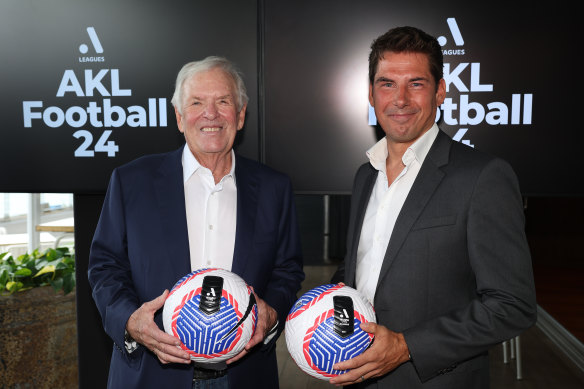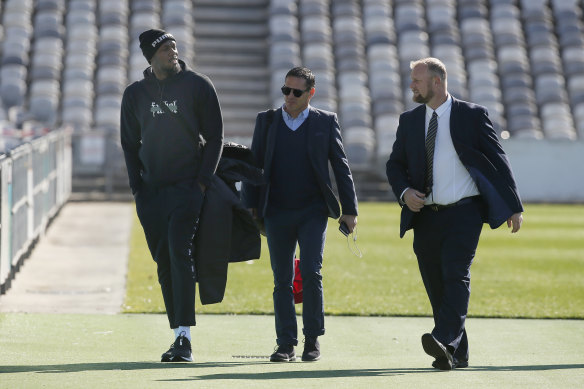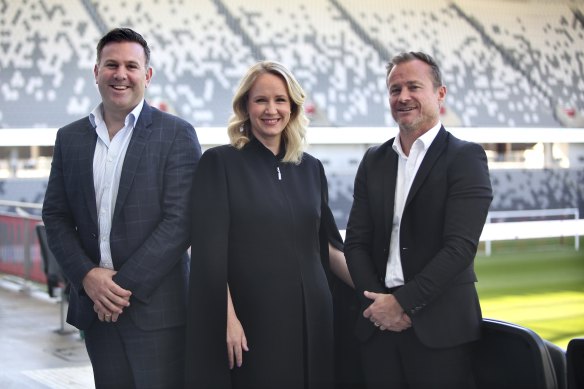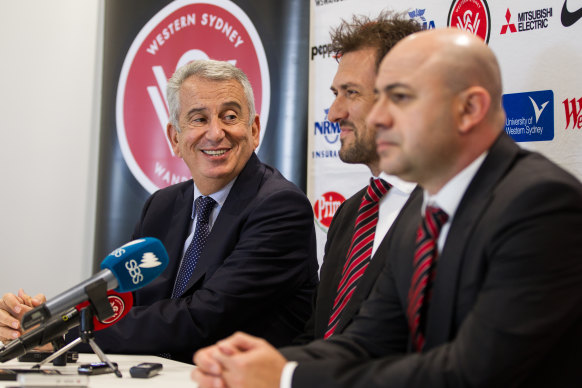This was published 1 year ago
How the A-Leagues’ multimillion-dollar digital play blew up
It’s Australian soccer’s unanswerable question: how do you convert the millions of people who play football at grassroots level, and watch European football obsessively, but don’t follow the A-Leagues?
By Vince Rugari

Australian soccer finds itself at yet another crossroad.Credit: Illustration: Monique Westermann
The latest drama to consume Australian soccer is the result of another failed attempt by administrators to answer the sport’s unanswerable question: how do you convert the millions of people who play football at grassroots level, and watch European soccer obsessively, but don’t follow the A-Leagues?
KeepUp, the digital arm of the Australian Professional Leagues that was shut down last week amid a brutal culling of jobs at head office, was a big, bold blueprint to do exactly that.
Depending on who you ask, KeepUp was either an expensive, misguided folly that burned through millions of dollars for zero return, or an ambitious idea that was ahead of its time and still could have worked out.
The truth, as usual, is somewhere in the middle.
The following picture has emerged after this masthead spoke to more than a dozen sources across the sport - most of whom requested anonymity, so they could talk freely about what has happened at APL, and how the $140 million cash injection provided by Silver Lake, the US private equity firm which bought a 33 per cent stake in the organisation two years ago, has been almost entirely spent, forcing them into mass redundancies.
The vision for KeepUp was much broader than a mere website or app, and was, in fact, a variation of an idea that the old Lowy-led Football Federation Australia regime was exploring. KeepUp was intended to be a one-stop digital shop for all things Australian football: a registration platform for grassroots participants, a competition management system, a news and content machine, a film studio and a direct-to-consumer streaming service. Part of the plan was that APL would buy up broadcast rights for secondary overseas competitions – like Germany’s Bundesliga and Spain’s La Liga, for instance – so that, to watch them, viewers would have to go through the A-Leagues and could be marketed to directly. Attracting high-profile teams to play in Australia against the A-Leagues All Stars, and mining the data of all ticket-buyers, was another element of what the APL’s now-departed chief commercial officer Ant Hearne described as a “conversion play”.
A report by Guardian Australia last year, about a “special purpose vehicle” company which Football Australia once briefly contemplated in 2020, is another piece of the puzzle. APL wanted KeepUp to be a joint venture with FA, so it could be plugged into the federation’s database of the nearly two million participants in Australia, and the A-Leagues could finally speak to them. While the vehicle never drove out of the dealership, sources say the APL and FA were in discussions regarding KeepUp’s grassroots utility until very recently.

Bill Foley, the owner of the incoming Auckland franchise, with Nick Garcia, the A-Leagues commissioner.Credit: Getty
Silver Lake invested precisely because it believed in the APL’s vision for KeepUp – making the “what ifs” about how else the $140 million could have otherwise been spent a bit of a furphy – but it never fully came to life.
Why?
Again, that depends on who you ask.
According to several sources, at the start of the financial year, an audit of the APL’s finances was conducted, and the findings were supposedly alarming. Among those who looked under the hood was James Rushton, who was the managing director of KeepUp, and since the departure of former chief executive Danny Townsend in October has led the APL at executive level, in tandem with commissioner Nick Garcia. Rushton is one of the founders of DAZN, a streaming service which has the rights to the NFL outside of the US and China; presumably he would know a bit about digital strategy. The events of last week were the result, averting what would have been a much bigger catastrophe had the status quo remained for much longer.
No, the A-Leagues aren’t about to fall over - but they might have.
Some clubs never agreed with the KeepUp strategy to begin with, but because they didn’t have a seat on the APL’s board, they never got a say, never really knew how it was tracking, and never saw any financial records. Sources described the APL as having a crash-or-crash-through culture akin to an aggressive Silicon Valley start-up, where those in charge did not listen to conflicting advice.
Owners and executives at those clubs watched on with horror as the APL’s expenses piled up, and the hiring spree went on and on, while their distributions went in the other direction, slumping this season to an all-time low of $2 million, sources say. Meanwhile, the APL allegedly spent the same amount on commissioning a song called Real Nice (H.C.T.F.), which was the A-Leagues’ broadcast theme music for two seasons and launched for the 2021/22 campaign. A music industry source confirmed around $750,000 went to an agency that managed the production of the track and its matching video, as well as payment for the artists, Tkay Maidza, Young Franco and Nerve, who did their job and produced a banger. The broader marketing campaign and rebrand that the song was a central part of, though, cost $3 million all up, according to sources.
Whether it was value for money is a valid question - but as another source put it, the same voices howling at the APL now are the same ones who’d be complaining if they didn’t try to make a big splash in their first season after ‘unbundling’ from FA.

Young Franco and Tkay Maidza, two of the artists behind the track which the A-Leagues spent $2 million on - much to the anger of some clubs.Credit: APL
From that perspective, the job losses were regrettable, but a necessary evil, and a signal of an overdue shift. The APL was trying to be a media company, but is now re-focusing on its core business: running a football competition. If the Scottish Professional Football League can run off a staff headcount in the 20s, then there was never any need for the APL to be pushing close to 100, they argue.
“We were more worried if they didn’t make those decisions,” said Shaun Mielekamp, the chief executive of the Central Coast Mariners, on the Coast Football Ramble podcast. “The league was headed down a path that looks very rosy in strategy, but the reality of costs and returns and revenues were very different. I know not all the clubs feel the same way ... [but] we’ve been pulling our hair out, watching how much money has been getting spent on things that we haven’t felt they’ve been productive. We’re a club that is used to cutting our cloth and living within our means. We think that this is just a moment in time for them to clean it up and reset so that the long-term future of the league is a bit more stable and protected than the reckless spending that they were doing.”
Various estimations have put the KeepUp expenditure somewhere between $30 million to $50 million, but another well-placed source said it was carved up like this:
Around $20 million went on “digital infrastructure”, including websites and apps for the league and all 12 clubs and a ‘smart’ system that tracked the behaviour of fans and compiled them into a database which would become valuable to the APL and future partners, central to the whole KeepUp concept. Due to issues with a supplier, costs blew out.

Central Coast Mariners chief executive Shaun Mielekamp (right) with Usain Bolt in 2018.Credit: AP
And a further $20 million was spent on KeepUp itself – paying staff, sending them around the country (and to the World Cup in Qatar), and buying equipment to generate the content they produced, such as A-Leagues All Access, a Drive to Survive-style weekly documentary series which was turned around just days after being filmed last season. In lieu of any other major media outlets covering the daily grind of the A-Leagues, KeepUp was doing a lot of heavy lifting; the whole plan was to use their content and social media strategy to boost engagement as high as possible so that the APL had something to work with when negotiations for their next broadcast deal rolled around.
A projected $100 million in fees generated by four planned expansion teams - Auckland and Canberra next season, then two others to follow - was supposed to keep the APL’s finances healthy in the interim. But as negotiations dragged on, decision-makers became nervous, one source says, and other issues continued to siphon away the money: $15 million in loans to clubs, a previous multi-million dollar loan which needed servicing, overhang from COVID-19, including the temporary relocation of Perth Glory and Wellington Phoenix, FA’s share of revenue as part of the independence agreement. Throw in the ongoing stewardship of Perth Glory, which is costing $1 million every month after a previous sale fell through - and is now impacting the integrity of the competition, after the APL instructed them to send Tunisian star Salim Khelifi on loan to Melbourne Victory to get a wage off their books, against the club’s will. (The APL itself does not own the ownerless Newcastle Jets - a group of individual club owners do, putting an indirect strain on the leagues’ finances.)

Network Ten’s co-chief executives Jarrod Villani and Beverley McGarvey with Danny Townsend, the former A-Leagues chief executive.Credit: James Alcock
And then there’s the broadcast deal with Network Ten and Paramount, supposedly worth $200 million over five years, or $40 million per season. It expires at the end of 2025-26, but Ten has a three-year option in their favour. Signed in 2021, the agreement was a real coup for the APL at the time, considering no other media companies were offering cash for the A-Leagues. But in practice, it was worth much less, as the APL has had to pay back Ten in ‘penalties’ for not hitting a prescribed benchmark of Paramount+ subscribers, as revealed by this masthead, which meant the APL had to underwrite distributions to clubs. Ten’s promotion of the A-Leagues, and what one source described as the network’s archaic digital strategy, has left a lot to be desired.
The APL also took on the responsibility of broadcast production, the associated costs of which also blew out to around $12 million per season after they chose to go with a new, untested start-up called Global Advance, instead of industry heavyweights NEP or Gravity - one of many big gambles that didn’t quite pay off.
Add all of those things up, and you get to $140 million quicker than you’d think - which explains why the APL were so desperate to do a deal with the NSW government to sell the grand final to Sydney, which was so despised by fans it triggered a violent pitch invasion at AAMI Park and turned Townsend into a public enemy, and why they have decided to yank the cord entirely on KeepUp.
Nobody at FA or APL believes an independent A-League was a mistake, and there is even broad agreement that the KeepUp vision was a very good one. But the clubs made all sorts of grand promises about the future of the A-Leagues if they took over, and they have simply not delivered. Many sources believe the APL had its priorities all wrong, went too hard too early, and was putting the cart before the horse: KeepUp could only have worked with perfect execution, and only if the A-Leagues’ fundamentals were strong. Neither box was ticked. To steal a line from Graham Arnold about the Socceroos’ Asian Cup campaign, pulling off such an ambitious digital play is much harder than it looks.

Paul Lederer (left) stepped down as APL chairman in September and left the board entirely before Christmas.Credit: Edwina Pickles
The APL has said nothing publicly since the job cuts, and many theories and figures have been tossed around in the information vacuum left behind. Garcia, Rushton and Stephen Conroy, the APL’s new independent chair, were unavailable for interview. Silver Lake declined to comment.
Townsend, who quit the APL in October for a gig in Saudi Arabia and was one of the main architects of KeepUp, also declined to comment, but briefly touched on the situation during an interview on sports business podcast Are You Not Entertained?
“It’s a challenging environment,” Townsend said. “We have so many foundational strengths as a sport in that country – the participation base of football is the sum of all the parts of the competing sports. So for that reason, I think there’s a sense of inevitability about where football will end up in Australia. What we were thinking was to accelerate that timeline, essentially, by the privatisation of the league. The current board have obviously gone and made some decisions in the last couple of weeks that I’m not across, but it would appear they’re winding back some of the investment that was made in content, particularly, from what I can tell, which is obviously their call.”
Paul Lederer, the Western Sydney Wanderers owner who stepped down as APL chair in September and left the board just before Christmas, and thus presided over all the spending, directed inquiries to the current board.
“I’m not going to go there,” Lederer said. “You’re better off to talk to Steve Conroy. For what it’s worth, we need good news in football, not bad news.”
Simon Pearce, another APL director and a hugely influential powerbroker in the Australian game, did not return calls. Pearce, who sits on the boards of the City Football Group and Manchester City and was one of the ringleaders of the A-League’s ‘unbundling’ push, is believed to have never given an on-record interview in the 10 years since he became involved in the A-Leagues through CFG’s purchase of Melbourne Heart.
It is not all doom and gloom for the A-Leagues, despite appearances. Broadcast, digital and other metrics are up, crowds are slightly up (albeit nowhere near pre-COVID levels), the football is still entertaining. People like US billionaire Bill Foley, who is adding the incoming Auckland franchise to his sporting group which includes AFC Bournemouth and the NHL’s Vegas Golden Knights, do not tip money into lost causes. There is hope that going back to basics might help the on-field product finally speak for itself, although it will lose some of its voice with KeepUp’s demise.
But the events of the past week are another self-inflicted black eye that the game could have done without. They raise big questions about the APL’s governance structure; it is hard to imagine things unravelling like this under a truly independent board, with a few more checks and balances. Not since the A-League era began in 2005 has domestic soccer suffered from such a crisis of credibility or relevance, in mainstream Australia but also among rusted-on, hardcore supporters.
“I do think there are people who’ve got to answer some questions,” said Richard Peil, the chairman of the Central Coast Mariners. “But more importantly, I think that the league has now realised that moving forward, the product has to be the focus.”
As for the question of turning participants and English Premier League fans into followers of domestic soccer, it’s back to the drawing board.
Watch every match of the UEFA Champions League, UEFA Europa League and UEFA Europa Conference League on Stan Sport. All the action streaming ad-free, live and on demand, with select matches in 4K UHD.
Sports news, results and expert commentary. Sign up for our Sport newsletter.